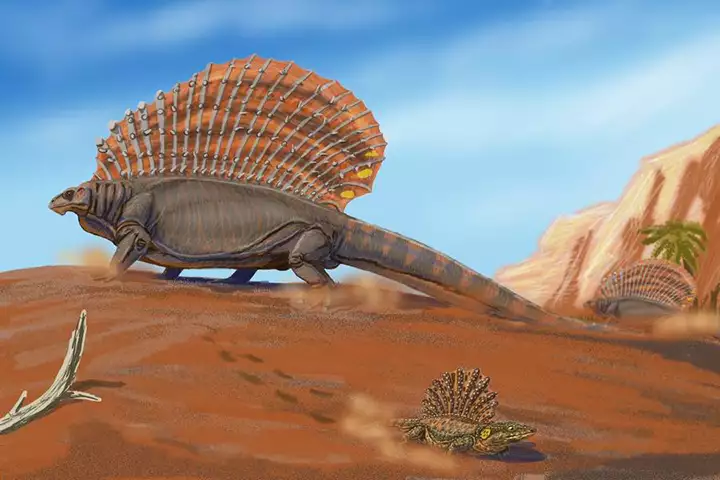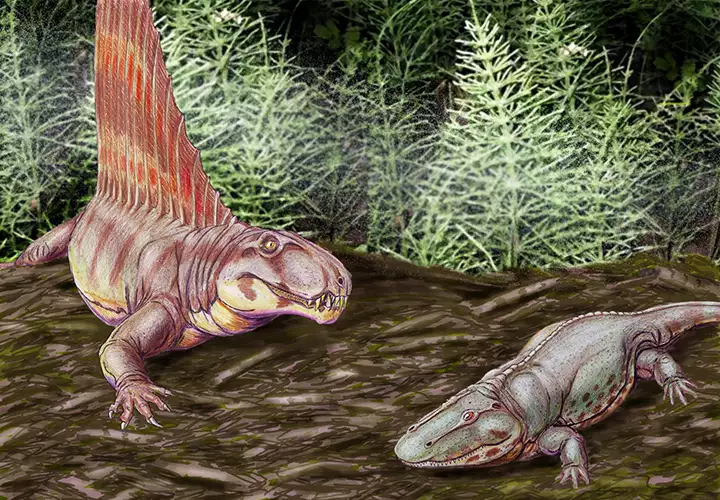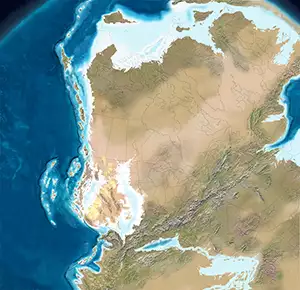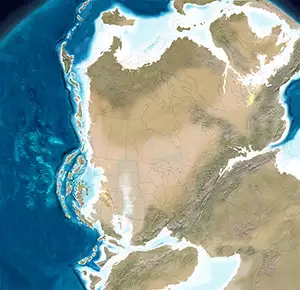The Permian Period

An edaphosaurus from Permian times
The Permian Period lasted from about 299 million years ago to about 251 million years ago. The Permian was the period of giant hard-shelled creatures: arthropods, insects and marine invertebrates.
The beginning of the Permian is dated during an Ice Age that began in the late Carboniferous. Rock strata from the era is dated using a multitude of marker skeletons and fossils. The distribution of those fossils indicate most of the land mass of the time was concentrated in a supercontinent named Pangaea. Pangea straddled the equator and reached toward the poles. The supercontinent was encircled by the Panthalassa (the universal sea) Ocean but the sheer size of the land mass precluded that the interior would either be hot and dry or cold and dry.
The period began with the half the planet gripped in an Ice Age and it took 20 million years for the climate to warm up and melt the glaciers back. Then during the rest of the Period, the climate alternated regularly between warm and cool.
Sea levels throughout the Permian were generally low but with all the land mass gathered in one clump, there was a shortage of continental margin and near-shore environments. It's felt that that was one of the contributing factors leading to the Permian-Triassic Extinction Event. Pangaea was shaped roughly like a huge "C", surrounded by the Panthalassa Ocean while holding the Paleo-Tethys Ocean inside the "C" between the land masses of Laurentia (to the north) and Gondwana (to the south).
In the early Permian, the Cimmerian plate rifted away from Gondwana and began a long, slow movement to the north that shrank the Paleo-Tethys Ocean while opening a trench to the south that became the Atlantic Ocean about 100 million years later. The end of the Permian found the Cimmerian plate colliding with Laurasia, causing the Cimmerian Orogeny that continued to push up mountains in Central Asia well into the Early Cenozoic. The areas of modern-day Turkey, Iran, Afghanistan, Tibet and western southeast Asia are what's left of the Cimmerian plate and the collision with Asia is still happening.
Today, only remnants of Permian deposits are found in what was then eastern Laurentia. There were widespread wind-blown and water-carried redbed deposits emplaced across the Western Interior and North Sea regions. Former ocean basins saw thick carbonate deposition while the surface of the planet itself underwent complex lateral and vertical facies changes. Global sea levels dropped late in the Permian, resulting in extensive salt deposition on the Laurentia craton from Nebraska to Texas and across Northern Europe. Western peri-Gondwanan terranes collided with Laurentia to begin the Marathon orogeny.
On the west, continued reorganization of the McCloud arc resulted in closure of the Havallah basin as the Quesnell Terrane collapsed toward Laurentia. The collapsing McCloud arc also initiated the Sonoman orogeny in what is now northern Nevada. During the Sonoman orogeny, the McCloud arc became reorganized with the Cache Creek interarc mélange forming between the Stikine and Quesnell Terranes. "Tethyian" limestone plateaus continued to obduct along western Laurentia and the McCloud Limestone formed on those terranes.

A dimetrodon and an eryops from the Permian Period
Maps © Ron Blakey NAU Geology, Deep Time Maps

